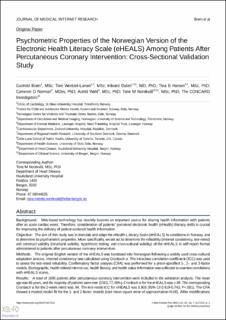| dc.description.abstract | Background:
Web-based technology has recently become an important source for sharing health information with patients after an acute cardiac event. Therefore, consideration of patients’ perceived electronic health (eHealth) literacy skills is crucial for improving the delivery of patient-centered health information.
Objective:
The aim of this study was to translate and adapt the eHealth Literacy Scale (eHEALS) to conditions in Norway, and to determine its psychometric properties. More specifically, we set out to determine the reliability (internal consistency, test-retest) and construct validity (structural validity, hypotheses testing, and cross-cultural validity) of the eHEALS in self-report format administered to patients after percutaneous coronary intervention.
Methods:
The original English version of the eHEALS was translated into Norwegian following a widely used cross-cultural adaptation process. Internal consistency was calculated using Cronbach α. The intraclass correlation coefficient (ICC) was used to assess the test-retest reliability. Confirmatory factor analysis (CFA) was performed for a priori-specified 1-, 2-, and 3-factor models. Demographic, health-related internet use, health literacy, and health status information was collected to examine correlations with eHEALS scores.
Results:
A total of 1695 patients after percutaneous coronary intervention were included in the validation analysis. The mean age was 66 years, and the majority of patients were men (1313, 77.46%). Cronbach α for the eHEALS was >.99. The corresponding Cronbach α for the 2-week retest was .94. The test-retest ICC for eHEALS was 0.605 (95% CI 0.419-0.743, P<.001). The CFA showed a modest model fit for the 1- and 2-factor models (root mean square error of approximation>0.06). After modifications in the 3-factor model, all of the goodness-of-fit indices indicated a good fit. There was a weak correlation with age (r=–0.206). Between-groups analysis of variance showed a difference according to educational groups and the eHEALS score, with a mean difference ranging from 2.24 (P=.002) to 4.61 (P<.001), and a higher eHEALS score was found for patients who were employed compared to those who were retired (mean difference 2.31, P<.001). The eHEALS score was also higher among patients who reported using the internet to find health information (95% CI –21.40 to –17.21, P<.001), and there was a moderate correlation with the patients’ perceived usefulness (r=0.587) and importance (r=0.574) of using the internet for health information. There were also moderate correlations identified between the eHEALS score and the health literacy domains appraisal of health information (r=0.380) and ability to find good health information (r=0.561). Weak correlations with the mental health composite score (r=0.116) and physical health composite score (r=0.116) were identified.
Conclusions:
This study provides new information on the psychometric properties of the eHEALS for patients after percutaneous coronary intervention, suggesting a multidimensional rather than unidimensional construct. However, the study also indicated a redundancy of items, indicating the need for further validation studies. | en_US |

